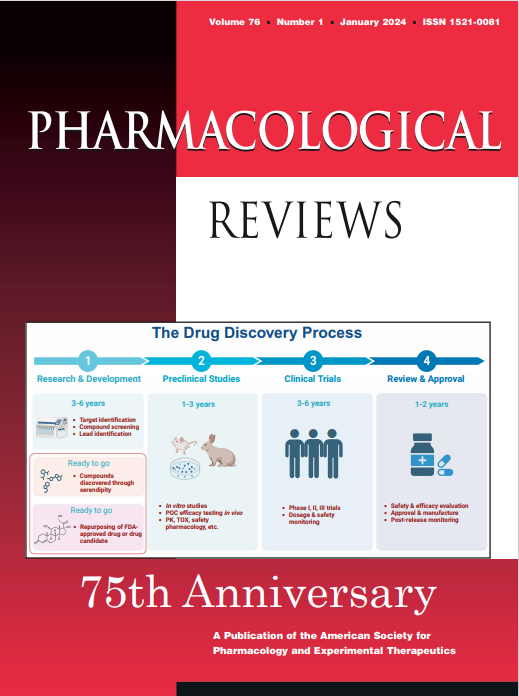Neuroactive Kynurenines as Pharmacological Targets: New Experimental Tools and Exciting Therapeutic Opportunities.
IF 17.3
1区 医学
Q1 PHARMACOLOGY & PHARMACY
引用次数: 0
Abstract
Both pre-clinical and clinical studies implicate functional impairments of several neuroactive metabolites of the kynurenine pathway (KP), the major degradative cascade of the essential amino acid tryptophan in mammals, in the pathophysiology of neurological and psychiatric diseases. A number of KP enzymes, such as tryptophan 2,3-dioxygenase (TDO2), indoleamine 2,3-dioxygenases (IDO1 and IDO2), kynurenine aminotransferases (KATs), kynurenine 3-monooxygenase (KMO), 3-hydroxyanthranilate oxidase (3-HAO), and quinolinic acid phosphoribosyltransferase (QPRT), control brain KP metabolism in health and disease and are therefore increasingly considered to be promising targets for the treatment of disorders of the nervous system. Understanding the distribution, cellular expression, and regulation of KP enzymes and KP metabolites in the brain is therefore critical for the conceptualization and implementation of successful therapeutic strategies. Significance Statement Studies have implicated the kynurenine pathway of tryptophan in the pathophysiology of neurological and psychiatric diseases. Key enzymes of the kynurenine pathway regulate brain metabolism in both health and disease, making them promising targets for treating these disorders. Therefore, understanding the distribution, cellular expression, and regulation of these enzymes and metabolites in the brain is critical for developing effective therapeutic strategies. In this review, we endeavor to describe these processes in detail.作为药理学靶点的神经活性犬尿氨酸:新的实验工具和令人兴奋的治疗机会。
临床前研究和临床研究都表明,犬尿氨酸途径(KP)的几种神经活性代谢物的功能损伤与神经和精神疾病的病理生理学有关,KP 是哺乳动物体内必需氨基酸色氨酸的主要降解级联。一些 KP 酶,如色氨酸 2,3-二氧化酶(TDO2)、吲哚胺 2,3-二氧化酶(IDO1 和 IDO2)、犬尿氨酸氨基转移酶(KATs)、犬尿氨酸 3-单氧化酶(KMO)、3-羟基蒽酸氧化酶(3-HAO)、和喹啉酸磷酸核糖转移酶(QPRT)控制着健康和疾病状态下的脑 KP 代谢,因此越来越多地被认为是治疗神经系统疾病的有希望的靶点。因此,了解 KP 酶和 KP 代谢物在大脑中的分布、细胞表达和调控对于构思和实施成功的治疗策略至关重要。意义声明 研究表明,色氨酸的犬尿氨酸途径与神经和精神疾病的病理生理学有关。犬尿氨酸途径的关键酶调节健康和疾病状态下的大脑代谢,因此成为治疗这些疾病的有希望的靶点。因此,了解这些酶和代谢物在大脑中的分布、细胞表达和调控对于开发有效的治疗策略至关重要。在这篇综述中,我们将努力详细描述这些过程。
本文章由计算机程序翻译,如有差异,请以英文原文为准。
求助全文
约1分钟内获得全文
求助全文
来源期刊

Pharmacological Reviews
医学-药学
CiteScore
34.70
自引率
0.50%
发文量
40
期刊介绍:
Pharmacological Reviews is a highly popular and well-received journal that has a long and rich history of success. It was first published in 1949 and is currently published bimonthly online by the American Society for Pharmacology and Experimental Therapeutics. The journal is indexed or abstracted by various databases, including Biological Abstracts, BIOSIS Previews Database, Biosciences Information Service, Current Contents/Life Sciences, EMBASE/Excerpta Medica, Index Medicus, Index to Scientific Reviews, Medical Documentation Service, Reference Update, Research Alerts, Science Citation Index, and SciSearch. Pharmacological Reviews offers comprehensive reviews of new pharmacological fields and is able to stay up-to-date with published content. Overall, it is highly regarded by scholars.
 求助内容:
求助内容: 应助结果提醒方式:
应助结果提醒方式:


